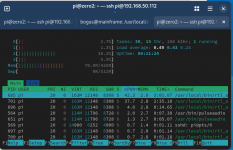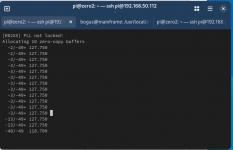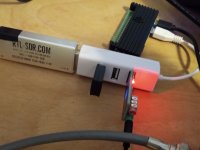cvthompson
Member
- Joined
- Jul 7, 2025
- Messages
- 18
- Reaction score
- 1
dkcorlfla,
Oh man! Thanks again.
When I run "cmake" I get this:
<snip on>
charlievictor102@n701gt:~ $ cd RTLSDR-Airband/
charlievictor102@n701gt:~/RTLSDR-Airband $ cd build
charlievictor102@n701gt:~/RTLSDR-Airband/build $ cmake ../
-- Build type not specified: defaulting to Release
-- Found lame includes: /usr/include/lame/lame.h
-- Found lame library: /usr/lib/aarch64-linux-gnu/libmp3lame.so
-- Checking for module 'libmirisdr'
-- Package 'libmirisdr', required by 'virtual:world', not found
-- Could NOT find MiriSDR (missing: MIRISDR_LIBRARY MIRISDR_INCLUDE_DIR)
-- Checking for SoapySDR
-- Could NOT find SoapySDR (missing: SoapySDR_DIR)
-- SoapySDR not found
-- RTLSDR-Airband configuration summary:
-- - Version string: v5.1.1
-- - Build type: Release
-- - Operating system: Linux
-- - SDR drivers:
-- - librtlsdr: requested: ON, enabled: TRUE
-- - mirisdr: requested: ON, enabled: FALSE
-- - soapysdr: requested: ON, enabled: FALSE
-- - Other options:
-- - Platform: native
-- - Build Unit Tests: FALSE
-- - Broadcom VideoCore GPU: FALSE
-- - NFM support: OFF
-- - PulseAudio: requested: ON, enabled: TRUE
-- - Profiling: requested: OFF, enabled: FALSE
-- - Icecast TLS support: TRUE
-- Configuring done
-- Generating done
-- Build files have been written to: /home/charlievictor102/RTLSDR-Airband/build
<snip off>
I don't think I'm missing "libpulse-dev". I get this:
<snip on>
charlievictor102@n701gt:~/RTLSDR-Airband/build $ cd
charlievictor102@n701gt:~ $ sudo apt install libpulse-dev
Reading package lists... Done
Building dependency tree... Done
Reading state information... Done
libpulse-dev is already the newest version (16.1+dfsg1-2+rpt1).
The following packages were automatically installed and are no longer required:
libbasicusageenvironment1 libgroupsock8 liblivemedia77
Use 'sudo apt autoremove' to remove them.
0 upgraded, 0 newly installed, 0 to remove and 3 not upgraded.
charlievictor102@n701gt:~ $
<snip off>
I ran your "cmake" options and I get this:
<snip on>
charlievictor102@n701gt:~/RTLSDR-Airband $ cd build
charlievictor102@n701gt:~/RTLSDR-Airband/build $ cmake -DPLATFORM=rpiv2 -DMIRISDR=OFF -DSOAPYSDR=OFF -DSOAPYSDR=OFF -DPULSEAUDIO=ON -DNFM=ON ../
-- Build type not specified: defaulting to Release
-- Found lame includes: /usr/include/lame/lame.h
-- Found lame library: /usr/lib/aarch64-linux-gnu/libmp3lame.so
-- The ASM compiler identification is GNU
-- Found assembler: /usr/bin/c++
-- Could NOT find BCM_VC (missing: BCM_VC_LIBRARY BCM_VC_INCLUDE_DIR)
-- RTLSDR-Airband configuration summary:
-- - Version string: v5.1.1
-- - Build type: Release
-- - Operating system: Linux
-- - SDR drivers:
-- - librtlsdr: requested: ON, enabled: TRUE
-- - mirisdr: requested: OFF, enabled: FALSE
-- - soapysdr: requested: OFF, enabled: FALSE
-- - Other options:
-- - Platform: rpiv2
-- - Build Unit Tests: FALSE
-- - Broadcom VideoCore GPU: FALSE
-- - NFM support: ON
-- - PulseAudio: requested: ON, enabled: TRUE
-- - Profiling: requested: OFF, enabled: FALSE
-- - Icecast TLS support: TRUE
-- Configuring done
-- Generating done
-- Build files have been written to: /home/charlievictor102/RTLSDR-Airband/build
<snip off>
Does this mean I'm missing "BCM_VC"? In case it is not clear, I am a complete NOOB when it comes to Linux and Raspberry Pi.
Curtis
Oh man! Thanks again.
When I run "cmake" I get this:
<snip on>
charlievictor102@n701gt:~ $ cd RTLSDR-Airband/
charlievictor102@n701gt:~/RTLSDR-Airband $ cd build
charlievictor102@n701gt:~/RTLSDR-Airband/build $ cmake ../
-- Build type not specified: defaulting to Release
-- Found lame includes: /usr/include/lame/lame.h
-- Found lame library: /usr/lib/aarch64-linux-gnu/libmp3lame.so
-- Checking for module 'libmirisdr'
-- Package 'libmirisdr', required by 'virtual:world', not found
-- Could NOT find MiriSDR (missing: MIRISDR_LIBRARY MIRISDR_INCLUDE_DIR)
-- Checking for SoapySDR
-- Could NOT find SoapySDR (missing: SoapySDR_DIR)
-- SoapySDR not found
-- RTLSDR-Airband configuration summary:
-- - Version string: v5.1.1
-- - Build type: Release
-- - Operating system: Linux
-- - SDR drivers:
-- - librtlsdr: requested: ON, enabled: TRUE
-- - mirisdr: requested: ON, enabled: FALSE
-- - soapysdr: requested: ON, enabled: FALSE
-- - Other options:
-- - Platform: native
-- - Build Unit Tests: FALSE
-- - Broadcom VideoCore GPU: FALSE
-- - NFM support: OFF
-- - PulseAudio: requested: ON, enabled: TRUE
-- - Profiling: requested: OFF, enabled: FALSE
-- - Icecast TLS support: TRUE
-- Configuring done
-- Generating done
-- Build files have been written to: /home/charlievictor102/RTLSDR-Airband/build
<snip off>
I don't think I'm missing "libpulse-dev". I get this:
<snip on>
charlievictor102@n701gt:~/RTLSDR-Airband/build $ cd
charlievictor102@n701gt:~ $ sudo apt install libpulse-dev
Reading package lists... Done
Building dependency tree... Done
Reading state information... Done
libpulse-dev is already the newest version (16.1+dfsg1-2+rpt1).
The following packages were automatically installed and are no longer required:
libbasicusageenvironment1 libgroupsock8 liblivemedia77
Use 'sudo apt autoremove' to remove them.
0 upgraded, 0 newly installed, 0 to remove and 3 not upgraded.
charlievictor102@n701gt:~ $
<snip off>
I ran your "cmake" options and I get this:
<snip on>
charlievictor102@n701gt:~/RTLSDR-Airband $ cd build
charlievictor102@n701gt:~/RTLSDR-Airband/build $ cmake -DPLATFORM=rpiv2 -DMIRISDR=OFF -DSOAPYSDR=OFF -DSOAPYSDR=OFF -DPULSEAUDIO=ON -DNFM=ON ../
-- Build type not specified: defaulting to Release
-- Found lame includes: /usr/include/lame/lame.h
-- Found lame library: /usr/lib/aarch64-linux-gnu/libmp3lame.so
-- The ASM compiler identification is GNU
-- Found assembler: /usr/bin/c++
-- Could NOT find BCM_VC (missing: BCM_VC_LIBRARY BCM_VC_INCLUDE_DIR)
-- RTLSDR-Airband configuration summary:
-- - Version string: v5.1.1
-- - Build type: Release
-- - Operating system: Linux
-- - SDR drivers:
-- - librtlsdr: requested: ON, enabled: TRUE
-- - mirisdr: requested: OFF, enabled: FALSE
-- - soapysdr: requested: OFF, enabled: FALSE
-- - Other options:
-- - Platform: rpiv2
-- - Build Unit Tests: FALSE
-- - Broadcom VideoCore GPU: FALSE
-- - NFM support: ON
-- - PulseAudio: requested: ON, enabled: TRUE
-- - Profiling: requested: OFF, enabled: FALSE
-- - Icecast TLS support: TRUE
-- Configuring done
-- Generating done
-- Build files have been written to: /home/charlievictor102/RTLSDR-Airband/build
<snip off>
Does this mean I'm missing "BCM_VC"? In case it is not clear, I am a complete NOOB when it comes to Linux and Raspberry Pi.
Curtis




